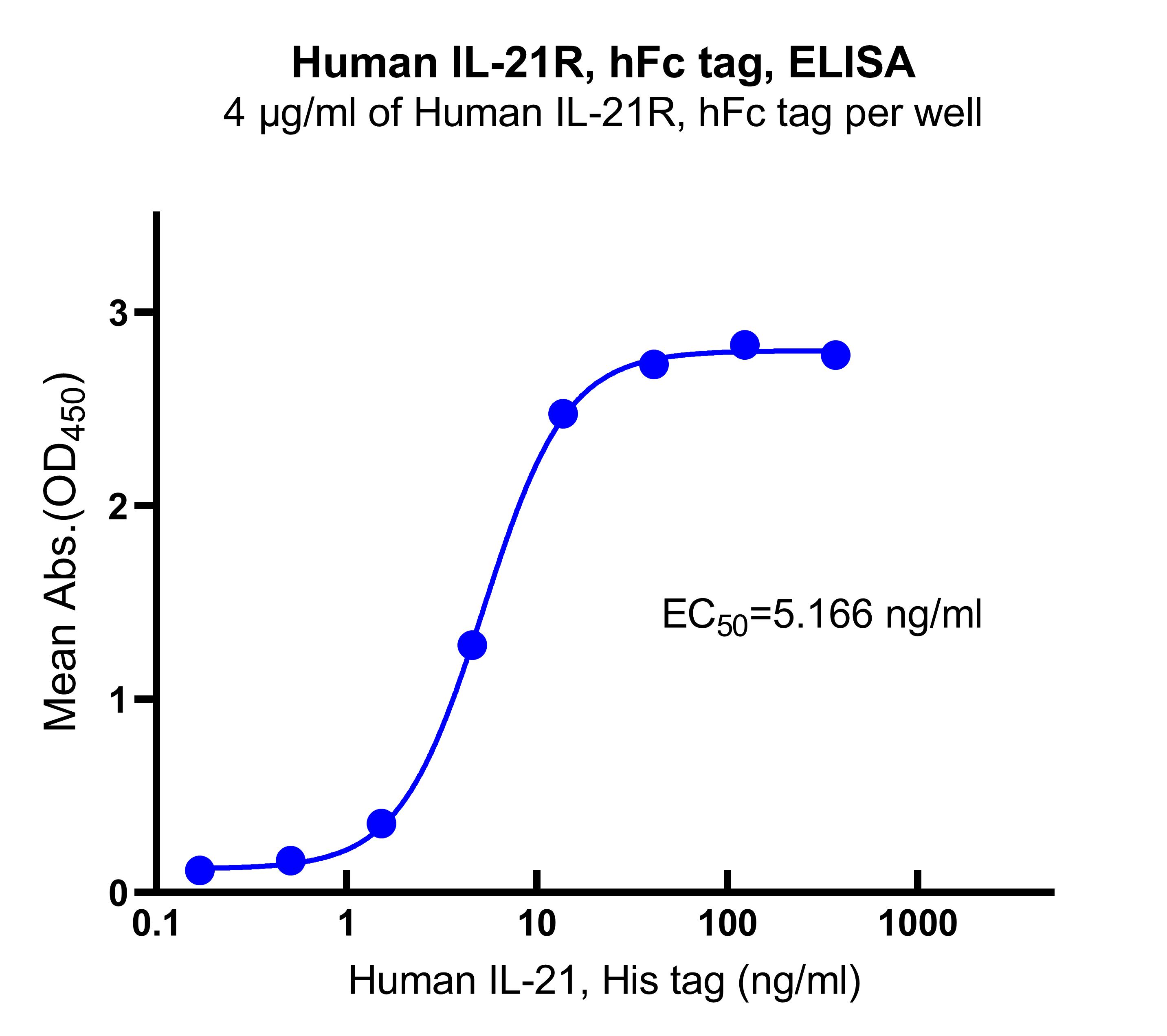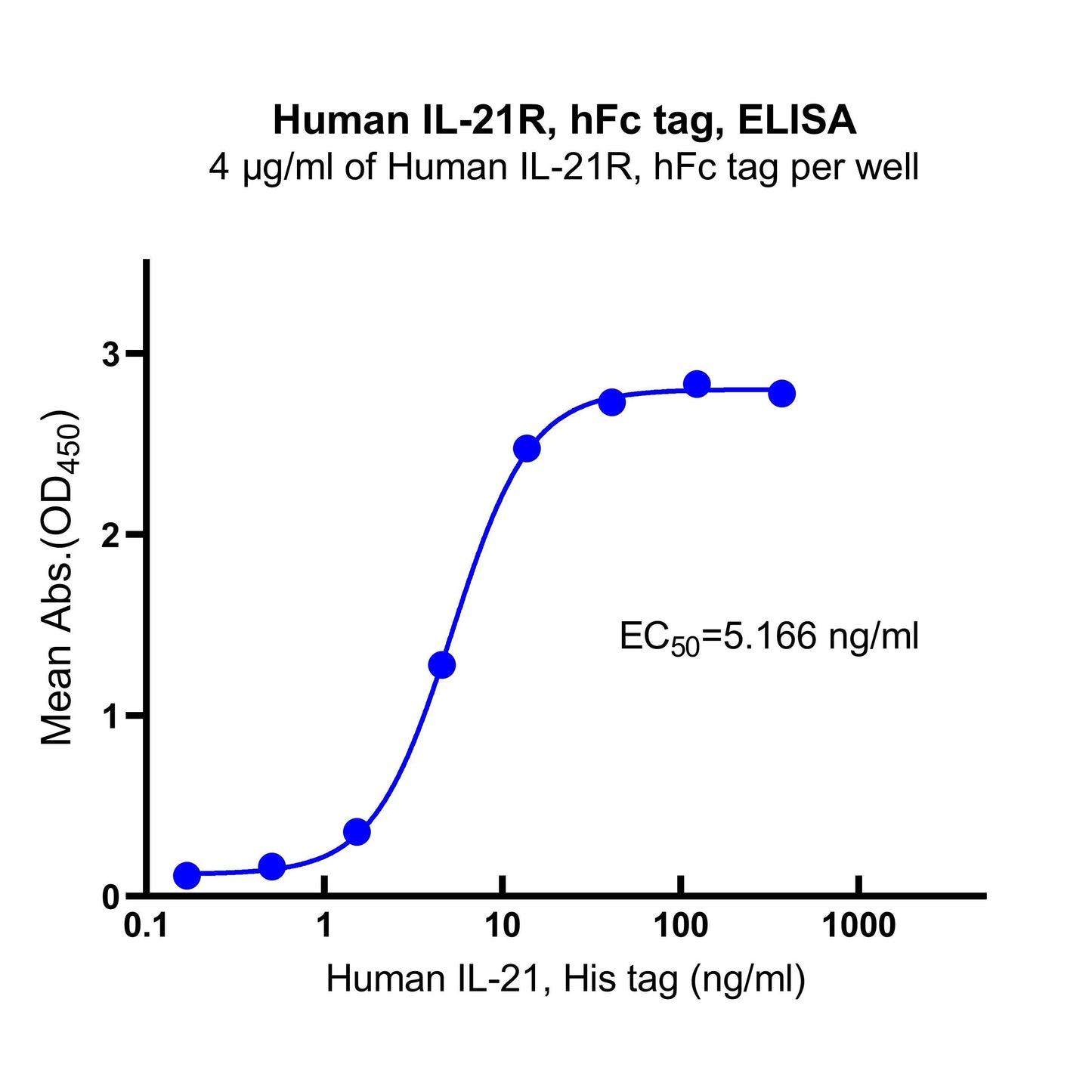Immobilized Human IL-21R, hFc tag at 10 μg/mL (50 μL/well) can bind Human IL-21, His tag (Cat. No. S0A4042) with EC50 of 4.878-5.470 ng/ml.
Product Details
Product Details
Product Specification
| Species | Human |
| Synonyms | Interleukin-21 receptor, IL-21 receptor, IL-21R, Novel interleukin receptor, CD360, NILR |
| Accession | Q9HBE5 |
| Amino Acid Sequence | Protein sequence (Q9HBE5, Cys20-Pro236, with C-hFc) CPDLVCYTDYLQTVICILEMWNLHPSTLTLTWQDQYEELKDEATSCSLHRSAHNATHATYTCHMDVFHFMADDIFSVNITDQSGNYSQECGSFLLAESIKPAPPFNVTVTFSGQYNISWRSDYEDPAFYMLKGKLQYELQYRNRGDPWAVSPRRKLISVDSRSVSLLPLEFRKDSSYELQVRAGPMPGSSYQGTWSEWSDPVIFQTQSEELKEGWNPEPKSCDKTHTCPPCPAPELLGGPSVFLFPPKPKDTLMISRTPEVTCVVVDVSHEDPEVKFNWYVDGVEVHNAKTKPREEQYNSTYRVVSVLTVLHQDWLNGKEYKCKVSNKALPAPIEKTISKAKGQPREPQVYTLPPSRDELTKNQVSLTCLVKGFYPSDIAVEWESNGQPENNYKTTPPVLDSDGSFFLYSKLTVDKSRWQQGNVFSCSVMHEALHNHYTQKSLSLSPGK |
| Expression System | HEK293 |
| Molecular Weight | Predicted MW: 51.1 kDa Observed MW: 75 kDa |
| Purity | >90% by SDS-PAGE |
| Endotoxin | <1EU/μg |
| Tag | with C-hFc |
| Physical Appearance | Lyophilized Powder |
| Storage Buffer | Lyophilized from a 0.2 μm filtered solution of 0.2M PBS, pH7.4. |
| Reconstitution | Reconstitute no more than 1 mg/mL according to the size in deionized water after rapid centrifugation. |
| Stability & Storage | 12 months from date of receipt, -20 to -70 °C as supplied. 6 months, -20 to -70 °C under sterile conditions after reconstitution. 1 week, 2 to 8 °C under sterile conditions after reconstitution. Please avoid repeated freeze-thaw cycles. |
Background
Interleukin 21 receptor is a cytokine receptor for interleukin 21 (IL21). It belongs to the type I cytokine receptors, and has been shown to form a heterodimeric receptor complex with the common gamma chain (γc), a receptor subunit also shared by the receptors for interleukin 2 (IL2), interleukin 7 (IL7) and interleukin 15 (IL15). This receptor transduces the growth promoting signal of IL21, and is important for the proliferation and differentiation of T cells, B cells, and natural killer (NK) cells. The ligand binding of this receptor leads to the activation of multiple downstream signaling molecules, including JAK1, JAK3, STAT1, and STAT3. Knockout studies of a similar gene in mouse suggest a role for this gene in regulating immunoglobulin production. Three alternatively spliced transcript variants encoding the same protein have been described.
Picture
Picture
Bioactivity

SDS-PAGE
2 μg(R: reducing conditions)


